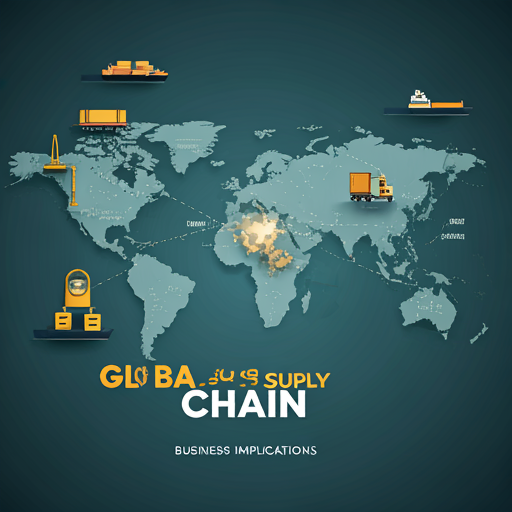Introduction to Global Supply Chain Disruptions
Overview of Supply Chain Dynamics
Global supply chain disruptions have become increasingly prevalent in recent years, significantly impacting businesses worldwide. He recognizes that these disruptions can stem from various factors, including geopolitical tensions, natural disasters, and pandemics. Such events can lead to delays, increased costs, and inventory shortages. This is a serious issue.
Moreover, the interconnectedness of global markets means that a disruption in one region can have ripple effects across the entire supply chain. He understands that companies must adapt to these challenges by enhancing their risk management strategies. It’s essential to stay prepared.
In this context, businesses are exploring innovative solutions, including the integration of technology and alternative sourcing strategies. He believes that embracing these changes can foster resilience. Change is necessary for growth.
Recent Events Impacting Global Supply Chains
Recent events have signkficantly impacted global supply chains, particularly in the wake of the COVID-19 pandemic. He notes that lockdowns and restrictions led to factory closures and transportation delays. This created a domino effect on inventory levels. It was a challenging time.
Additionally, geopolitical tensions have exacerbated these disruptions, causing fluctuations in trade policies and tariffs. He observes that such instability can lead to increased costs for businesses. This is a critical concern.
Furthermore, raw disasters have also played a role, disrupting logistics and supply routes. He emphasizes the importance of contingency planning in mitigating these risks. Preparation is key for success.
Understanding the Role of Cryptocurrency in Supply Chains
How Cryptocurrency Facilitates Transactions
Cryptocurrency facilitates transactions in supply chains by providing a decentralized and secure method for transferring value. This reduces reliance on traditional banking systems. It’s a modern solution.
Key benefits include:
He believes these features enhance operational efficiency. Efficiency is crucial for success.
Moreover, cryptocurrencies can streamline cross-border payments, eliminating currency conversion issues. This simplifies international trade. It’s a game changer.
By integrating cryptocurrency, businesses can improve cash flow management and reducs fraud risks. He emphasizes that these advantages are vital in today’s competitive landscape. Every advantage counts.
Blockchain Technology and Supply Chain Transparency
Blockchain technology enhances supply chain transparency by providing an immutable ledger for tracking products. This ensures that all transactions are recorded and verifiable. It’s a reliable system.
Key advantages include:
He notes that these features foster trust among stakeholders. Trust is essential in business.
Furthermore, real-time data access allows for quicker decision-making. This agility can lead to better resource management. It’s a strategic advantage.
By implementing blockchain, companies can also enhance compliance with regulations. He believes this is increasingly important in today’s market. Compliance is non-negotiable.
Implications for Businesses: Short-term Effects
Operational Challenges and Cost Increases
Operational challenges and cost increases have immediate implications for businesses navigating supply chain disruptions. He observes that companies often face delays in production and delivery. This can lead to lost sales opportunities. It’s a significant risk.
Additionally, rising costs for raw materials and transportation can strain budgets. He notes that these financial pressures may force businesses to increase prices. Price hikes can alienate customers.
Key challenges include:
He emphasizes that these factors can disrupt cash flow. Cash flow is vital for operations.
Moreover, businesses may need to invest in technology to enhance efficiency. This requires careful financial planning. Strategic investment is essential for growth.
Shifts in Consumer Behavior and Demand
Shifts in consumer behavior and demand have significant short-term effects on businesses. He notes that consumers are increasingly prioritizing sustainability and ethical sourcing. This change influences purchasing decisions. It’s a critical trend.
Moreover, the rise of
Long-term Strategic Changes for Businesses
Adoption of Decentralized Finance (DeFi) Solutions
The adoption of decentralized finance (DeFi) solutions is reshaping long-term strategies for businesses. He observes that DeFi offers innovative financial services without traditional intermediaries. This reduces transaction costs significantly. It’s a revolutionary approach.
Furthermore, businesses can access liquidity through decentralized exchanges, enhancing capital efficiency. He notes that this flexibility allows for better resource allocation. Flexibility is essential for growth.
Key benefits include:
He believes that integrating DeFi can lead to improved financial resilience. Resilience is crucial in volatile markets.
Resilience through Diversification and Innovation
Resilience through diversification and innovation is essential for long-term strategic changes in businesses. He emphasizes that diversifying product lines can mitigate risks associated with securities industry fluctuations. This approach enhances stability . Stability is vital for success.
Moreover, innovation in processes and technologies can lead to increased efficiency and reduced costs. He notes that adopting new technologies can streamline operations. Efficiency drives profitability.
Key strategies include:
He believes that these strategies foster adaptability in changing environments. Adaptability is crucial for survival. By embracing diversification and innovation, businesses can better navigate uncertainties. Uncertainty is a constant in business.
The Future of Supply Chains in a Cryptocurrency World
Emerging Trends and Technologies
Emerging trends and technologies are reshaping the future of supply chains in a cryptocurrency world. He notes that blockchain technology enhances transparency and traceability in transactions. This builds trust among stakeholders. Trust is essential for collaboration.
Additionally, the integration of artificial intelligence can optimize logistics and inventory management. He observes that AI-driven analytics provide valuable insights for decision-making. Insights lead to better strategies.
Key trends include:
He believes these innovations will streamline operations and reduce costs. Cost efficiency is a competitive advantage. As businesses adapt to these changes, they can enhance their rssilience in a dynamic market. Resilience is key to long-term success.
Preparing for Future Disruptions
Preparing for future disruptions requires businesses to adopt proactive strategies. He emphasizes the importance of risk assessment and scenario planning. This helps identify potential vulnerabilities. Vulnerabilities can lead to significant losses.
Moreover, investing in technology is crucial for enhancing supply chain resilience. He notes that automation and data analytics can improve responsiveness. Responsiveness is vital in crises.
Key strategies include:
He believes that these measures will enable businesses to navigate uncertainties effectively. Effective navigation is essential for survival. By staying prepared, companies can maintain operational continuity. Continuity is critical for success.
